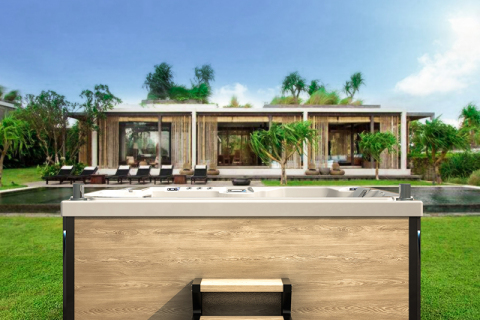
- Home
- >
News
First of all, from a technical point of view, hot tubs can be placed outdoors. Many hot tubs are designed with outdoor use in mind and have waterproof, windproof and weatherproof properties.
Outdoor hot tub involves water and electricity installation, drainage system, heating equipment, etc. If installed improperly, there may be problems such as water leakage, circuit failure, uneven heating, etc., and even affect the safety of users.
The first thing to consider is whether it can withstand the test of the outdoor environment. Secondly, given the variability of the outdoor environment, durability becomes an important factor in material selection. Finally, considering comfort and aesthetics, the selection of materials also needs to consider the comfort of the human body and the aesthetics of the overall environment.
Some medical studies indicate that soaking in moderately warm water can relieve symptoms in people with arthritis. Hot water tub outdoor provides an ideal environment in which patients can relax and enjoy a soak in warm water, soothing the muscles and ligaments around the joints, thereby reducing pain.
To adapt to seasonal changes, the water temperature adjustment of the outdoor hot bathtub is crucial. During the summer, you can lower the temperature of your hot tub slightly to prevent the water from overheating and causing discomfort. In cold winter, the water temperature needs to be raised to keep warm. By adjusting the water temperature according to the seasons, the hot water tub outdoor can provide comfortable enjoyment in different seasons.
Generally speaking, patients with high blood pressure can use hot water tubs moderately, but they need to pay attention to controlling the bathing time and water temperature to avoid excessive relaxation and fatigue. Especially for patients with unstable blood pressure control or other cardiovascular diseases, they should be used with caution under the guidance of a doctor to avoid adverse reactions.
Placing the hot water bathtub in a cool location protects it from potential damage caused by direct sunlight. After being exposed to the sun for a long time, the outer wall and parts of the hot water bathtub may become fragile due to ultraviolet rays and high temperature, and may even be damaged by deformation, cracking, etc. Placing the hot water bathtub in a cool place can effectively reduce this risk and extend the service life of the hot water bathtub.
Keeping the outside hot tub on does consume less power. Because when the outdoor hot tub is started frequently, the current surge during instantaneous start-up will cause greater energy loss. However, in the case of long-term smooth operation, the energy consumption is more stable and thus relatively more economical.
An outdoor hot tub and a jacuzzi bathtub may look similar in appearance, but there are distinct differences between them. The most important difference is that hot tub itself is a generic name, while jacuzzi bathtub is a brand name for hot tubs and spa products.
1. Expand blood vessels and promote blood circulation 2. Relieve muscle tension and reduce swelling 3. Reduce joint pressure and relieve joint pain 4. Improve mental state and reduce stress
1. High maintenance costs 2. Large energy consumption 3. Takes up a lot of space 4. Seasonal use is limited
As far as personal hot tubs are concerned, they are microbiologically relatively safe when properly cleaned and maintained. Generally speaking, the water quality of personal hot tubs is relatively stable and there is little environment for bacterial growth. Therefore, as long as you clean, disinfect and keep the water clean regularly, personal hot tub hygiene issues can be effectively controlled.












